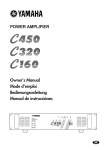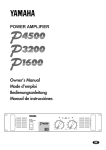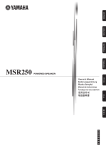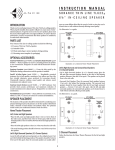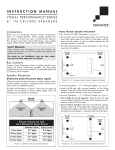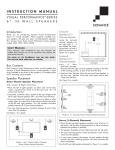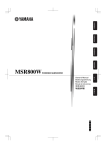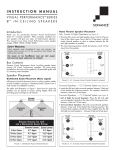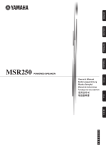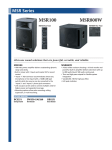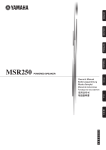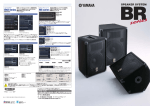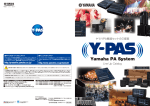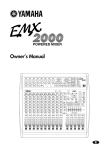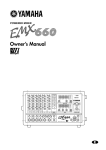Download Yamaha MSR100 loudspeaker
Transcript
Specifications MSR400 MSR250 MSR100 MSR800W Biamp. 2-way Powered Speaker 1.6 kHz (30 dB/oct.) 50 Hz – 20 kHz (-10 dB) 121 dB (1 m on Axis) 90° (H)/40° (V) 406 x 652 x 351 mm (16" x 25-3/4" x 13-7/8") 23 kg (50.7 lbs.) 2-way Powered Speaker 4 kHz (LF, HF: 12 dB/oct.) 55 Hz – 20 kHz (-10 dB) 116 dB (1 m on Axis) 90° (H)/40° (V) 342 x 544.5 x 298 mm (13-1/2" x 21-1/2" x 11-3/4") 14.1 kg (31.1 lbs.) 2-way Powered Speaker 4 kHz (LF, HF: 12 dB/oct.) 55 Hz – 20 kHz (-10 dB) 112 dB (1 m on Axis) 90° (H)/40° (V) 275 x 455.5 x 255 mm (10-7/8" x 18" x 10-1/8") 11 kg (24.2 lbs.) Powered Subwoofer — 40 – 120 Hz (-10dB) 122 dB (1 m on Axis) — 600 x 521 x 590 mm (23-5/8" x 20-5/8" x 23-1/4") 45 kg (99.1 lbs.) LF: 12" Cone HF: 1.75" V.C. Compression Driver Bass-reflex Type Polypropylene — 35-36 mm pole socket M8 x 2 LF: 10" Cone HF: 1" V.C. Compression Driver Bass-reflex Type Polypropylene — 35-36 mm pole socket M8 x 2 LF: 8" Cone HF: 1" V.C. Compression Driver Bass-reflex Type Polypropylene — Optional Speaker Stand Adaptor *1 M8 x 2 Bass-reflex Type Birch Plywood Black Sprayed 35 mm pole socket on top — EEEngine (LF), Class AB (HF) Biamplified system LF: 225 W/4 Ω HF: 75 W/16 Ω Maximum Power: 400 W Total Class D 200 W at 1 kHz. THD=1 %, RL=4 Ω Maximum Power: 250 W INPUT 1 (XLR): -60 dBu (Mic)/-30 dBu (Line), (PHONE): -50 dBu (Mic)/-20 dBu (Line), INPUT 2/3: -20 dBu INPUT 1: -50 dB (Mic)/+4 dB (Line), 10 kΩ (Line), (with select SW) INPUT 2 & 3: -10 dB, 10 kΩ (Line) +4dB/30 kΩ INPUT 1: XLR-3-31 (balanced) INPUT 2: XLR-3-32 (balanced) INPUT 3: PHONE (balanced) (All parallel) INPUT 1: XLR-3-31/PHONE (balanced) INPUT 2/3: PHONE/RCA-PIN (unbalanced) LINK OUT: PHONE (unbalanced) INPUT 1: XLR-3-31 (balanced) INPUT 2 & 3: PHONE (unbalanced) LINK OUT: PHONE (unbalanced) Input (ch-A & B): XLR-3-31 (balanced) THRU Out (ch-A & B): XLR-3-32 (balanced) High Pass Out (ch-A & B): XLR-3-32 (balanced) (100 Hz, 18 dB/oct, +4 dB) LEVEL CONTROL, EQ. LOW: ± 3 dB at 55 Hz, HIGH: ± 3 dB at 1.6 kHz, POWER Switch (ON/OFF) LEVEL CONTROL: INPUT 1, 2/3, EQ. LOW: ± 3 dB at 60 Hz, HIGH: ± 6 dB at 10 kHz, POWER Switch (ON/OFF) Power ON: Green LED Clipping: Red LED 110 W Power ON: Green LED Clipping: Red LED 40 W GENERAL Type Crossover Frequency Overall Frequency Response Maximum SPL Dispersion Dimensions (W x H x D) Weight SPEAKER SECTION Components Enclosure Type Material Finish Suspension/Mounting Mounting Screws *2 AMP SECTION Class Output Power Input Sensitivity/Impedance Mic/Line: -36 dB/+4 dB, 10 kΩ Input/Output Connectors Asymmetrical Cabinet Design Controls Sound bouncing around inside a speaker cabinet can have a significant effect on the sound that comes out. The biggest problem is standing Indicators waves that commonly occur between parallel surfaces. Standing waves Power Consumption can interfere with and color the speaker’s output, thus degrading sound 15" Cone Class H EEEngine 500 W at 100 Hz. THD=1 %, RL=8 Ω Maximum Power: 800 W 100 W at 1 kHz. THD=1 %, RL=6 Ω Level Control INPUT 1, 2 & 3, Master Level, EQ. LOW: ± 3 dB at 60 Hz, HIGH: ± 6 dB at 10 kHz, POWER Switch (ON/OFF) Power ON: Green LED Clipping: Red LED 70 W MASTER LEVEL CONTROL, CUTOFF FREQ. Control: 80 – 100 Hz (Variable), PHASE Switch: (NORM/REV), POWER Switch: ON/OFF Power ON: Green LED Clipping: Red LED 200 W • 0 dBu=0.775 V *1 Speaker stand adaptor is required to mount the tripod speaker stands. For example ADP138 (USA), Ultimate BMB200, or the equal one. *2 Optional brackets are not sold in all regions. Please check with your local subsidiary for availability. quality. The standard solution is acoustic insulation material inside the cabinet, which does help, but it doesn’t address the underlying problem of cabinet geometry. Yamaha has gone the extra mile in designing the MSR250 and MSR400 cabinets, employing a unique configuration that Dimensions eliminates parallel interior surfaces and therefore the root cause of MSR400 standing waves. Acoustic insulation is also applied to effectively deaden MSR250 MSR100 MSR800W Unit: mm 2-M8 depth 17 197 544.5 150 the most: your audience. 275 652 in compromised performance if heat generation is not effectively controlled. The current driving a speaker generates heat in the voice coil 120 Voice Coil 152 120 Any technology that involves power also involves heat, and this can result 255 298 342 137 Ferrofluid Cooling 2-M8 x 25 521 cabinet means that optimum sound can be delivered to where it counts 455.5 the space inside the enclosure. Elimination of unwanted sound inside the 2-M8 x 25 that, in extreme cases, can cause the speaker to burn out. But even if the Tripod pole diameter 35-36 mm speaker doesn’t actually burn out, that heat still results in inefficiency and * Use of the stand should refer to stand manufacturer’s instructions. 406 non-linearity that degrade overall performance. As the power and heat 351 600 590 increase, the resistance of the voice coil increases as well, causing power compression, a loss in acoustic output that reduces the system’s dynamic •Specifications and appearance subject to change without notice. •All trademarks and registered trademarks are property of their respective owners. range. This problem is overcome in the MSR100 and MSR250 by placing an advanced ferrofluid in the voice coil gap, where it serves to conduct heat away from the voice coil with much greater efficiency than air. The results are smooth, natural frequency response and dynamics as well as stable performance even under heavy use. Ferrofluid Diaphragm For details please contact: Magnet www.yamahaproaudio.com Printed in Japan LPA548 Portable, Compact Solutions for Superior Sound and Convenience Powered speakers offer many advantages over their passive counterparts, whether used on the road or in permanent installations. You don’t need separate amplifiers or the extra cables and connections required, so setup is fast and easy while reliability is significantly improved. The ability to plug directly into the speaker inputs can eliminate an entire rack of amplifiers in a modest-size system. But the benefits go beyond mere convenience. Optimum matching of amplifiers and speakers involves much more than simple impedance figures, and can be a formidable engineering task given the vast number of choices available. The Yamaha MSR-series power High-quality Portable Power All-in-one Sound that’s Powerful, Versatile, and Reliable The MSR250 delivers the ideal blend of power, performance, features, and portability for an exceptionally wide range of applications. A newly designed class D amplifier delivers 250 watts of clean, dynamic power via a high-performance 10-inch cone woofer and 1-inch titanium-dome compression driver that match up perfectly for smooth, uncolored response from 55 Hz to 20 kHz. The woofer has an oversized 2.5-inch aluminum voice coil—a size you’d normally see on a 15-inch woofer—that contributes to outstanding sound and durability. With all this power and performance the big surprise is how light and manageable this advanced powered speaker is. The MSR100 fills a variety of sound reinforcement and stage monitor needs in one lightweight package: mixer, power amplifier, and speaker system in a single, compact unit that’s perfect for small events and club gigs. Mix the output from a CD player, rhythm machine and/or keyboard with your voice, for example, without having to use a separate mixer or power amplifier. Two-band EQ gives you further control over the final sound. The built-in 100-watt power amplifier delivers plenty of punch so you’ll be heard with full dynamic range and clarity. An 8" custom woofer handles the low frequencies, while a 1" titanium diaphragm compression driver delivers the highs. For larger events the MSR100’s link out jack can be used to connect multiple units for higher power and expanded coverage. A variety of mounting options allow pole mounting, ceiling suspension, or wall mounting, and you can safely stack multiple units on the stage. Versatile Dual-channel Input Configuration For extra input flexibility the MSR250 features dual input channels, each with it’s own low and high equalizer controls and level control. The signals from the two inputs are mixed and delivered via the MSR250 speakers as well as the rear-panel line out connector, allowing convenient linking to other speakers or audio devices for easy system expansion (the MSR250 is a perfect expansion speaker for Yamaha’s STAGEPAS 250M compact sound system). Input 1 has balanced XLR and phone jack connectors that accept microphone or line input, and input 2/3 is actually a mixing input in its own right with phone jack and two pin jack connectors. Sound You Can Feel Built for Heavy Duty Use Although it’s lightweight and easy to handle, the MSR250 is exceptionally durable and will take the most demanding tours in stride. It’s also designed to be used in a variety of situations, including normal upright and wedge-style floor monitor operation. There’s also a built-in pole-mount receptacle for convenient stand mounting. REAR PANEL amplifiers have been ideally mated to their respective speakers in every way possible, REAR PANEL The MSR800W powered subwoofer is a perfect companion for the MSR400, MSR250, or MSR100 extending the low end and completing the musical spectrum for maximum punch and impact. The high-quality birch plywood bass-reflex cabinet houses a 15" cast frame woofer powered by an ultra-efficient 800 watt (max) amplifier, a configuration that can deliver the elusive 40 Hz through 120 Hz frequency range with precision and authority. Two balanced XLR connectors are provided for connection to the source, and that same signal can be directly passed on to the main speakers via a pair of XLR “THRU” outputs. Alternatively, the main speakers can be fed by the MSR800W’s dual “HIGH PASS” outputs, high-pass filtered at 80 Hz through 100 Hz, depending on the setting of the cutoff frequency control, with a steep 18 dB/octave cutoff slope. REAR PANEL delivering reproduction quality that only the most stringent matching can achieve. There are also a significant number of Yamaha refinements that put these extraordinary powered speakers in a class of their own, including an original cabinet design that eliminates internal standing waves and ferrofluidcooled voice coils for superior stability and linearity. The MSR250, MSR400 or MSR100 powered speakers can be used alone or in combination with the MSR800W powered subwoofer to create sound reinforcement systems from modest to massive that will sound superb while delivering the power and coverage you need for success in just about any venue or at any event. They look great too, and can be used as-is in many permanent installations without requiring any cosmetic cover-up. They’re more than rugged enough for demanding tour applications as well. Application Examples Brawn Meets Beauty The MSR400’s authoritative sound and refined appearance give it both brawn and beauty, making it a great choice for a wide array of performing and live-sound situations. The MSR400 employs a two-way bi-amplified system that delivers a total of 400 watts to the 12-inch cone type woofer and the 1.75-inch high-frequency horn driver. In addition to the green LED that lights when the power is turned on, there’s a peak LED that lights red when an input overload occurs. This provides a visual indication of excessive input, allowing you to adjust the input level appropriately. Mid-size Live Sound Small PA This system delivers plenty of power as well as majestic bass with a pair of MSR400 powered speakers connected via the THRU outputs of an MSR800W subwoofer. A pair of MSR100 powered speakers serve as floor monitors for the performers. This small and extremely portable system can be set up and taken down in a matter of minutes. It delivers spectacular sound, too. Mics MG124CX MG124CX MG206C Mics ST OUT R Inputs for a Variety of Sources MONITOR OUT R ST OUT L The MSR400 provides three input connectors; male and female XLR type connectors and a phone jack. All inputs are balanced and connected in parallel. The input level range is from -36 dB to +4 dB, allowing the MSR400 to accept output from your mixer as well as other sources such as microphones, synthesizers, or other electronic musical instrument. The control section includes input level adjustment and a two-band equalizer so you can make fine adjustments for optimum matching with your input source. MONITOR OUT L Q2031B MOTIF XS8 A Range of Mounting Options The MSR400 can be mounted and positioned in a number of ways to meet the needs of venues or events. It can be placed vertically on the floor, used as a stage monitor, or even mounted on a speaker stand for improved projection. The top surface of the cabinet provides 8-mm threaded holes that facilitate wall or ceiling mounting. ST OUT R ST OUT L MSR400 MSR250 MSR250 MSR400 Visual Clip Indication MSR800W REAR PANEL F.O.H MSR100 MSR100 MONITOR The MSR series features an LED power indicator as well as a clip indicator that warns of impending clipping, allowing the user to make appropriate adjustments to the source level.


